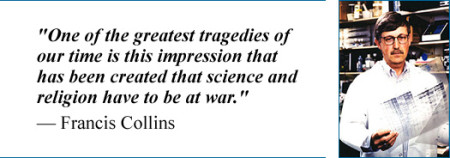I wrote the following piece in December of 1998 for LRN 131 class…
(in the interest of consistency, I’ve made a few edits before posting)

“One of the greatest tragedies of our time is this impression that has been created that science and religion have to be at war.” – Francis Collins
For many decades now, there has been an ongoing debate about the differences between science and religion, and the issues that set them apart from one another. While many renowned scientists, philosophers and scholars have extensively contrasted the two schools of thought time and time again, there has been little discussion comparing the similarities they share. Yet, upon juxtaposing science and religion, there appear to be quite a few core beliefs held by both ideologies.
To begin, both science and religion are based upon a never-ending search for a greater knowledge, wisdom and understanding of the universe. Most religions strongly emphasize the idea that seekers and scholars must obtain wisdom, understanding and knowledge of self, the earth, and also of the universe in order to become closer to and more familiar with Spirit (also known as “Consciousness”), and the Universal Creator of such. This is done using holy texts, nature symbology, traditions, and prophecy. Similarly, science emphasizes the idea that researchers and scholars must identify, understand and unify all forms of knowledge and wisdom throughout the universe in order to become closer to Nature (also known as “reality”). This is done using textbooks, symbolism, hypothesis, and ideas. With all of this in mind, science and religion appear to operate as two independent schools of thought, with each being in possession of a library of useful information for humanity to sort through and process.
As expected, however, some do not completely agree with the idea that science and religion have similar goals, or that they even overlap, whatsoever. Many actually view the two areas of focus as mutually exclusive. As Bryan Appleyard put it, “science and religion are two completely different ways of understanding reality.” Some feel that religion deals with transcendental concepts, such as a Universal Creator, the Soul, Spirit and the Everlasting/Afterlife (concepts that can not be proven to exist by modern science), while science deals in substance. As stated by Francis Crick, the “majority” of neuro-scientists “believe that the idea of the soul is a myth.” However, there is an obvious problem with this somewhat dismissive over-generalization. Even if religion does deal solely with “the unseen” (which is not actually the case, as I will discuss, shortly), science does not deal solely in the material world. This belief contradicts two of the most important aspects of science: hypothesis and theory.
Carl Hempel made a very powerful argument for the existence of theoretical entities (entities that show strong signs of existing, but have never been physically observed). Generally, he said that if science were to study only things that can be observed, researchers would only have a limited range of understanding, and a limited account for why things happen. In Hempel’s view, by using theoretical entities in science, researchers are able to gain a much more comprehensive and exact account of the things happening in our world. It is easily observable that history tends to agree with Hempel. Science is wrought with examples wherein theoretical science alone forms the basis for a new science that is only later proven to exist using physical means. From Pasteur’s unseen pathogens, to Newton’s invisible gravitational force, to Einstein’s imperceptible photons, science thrives on ideas and possibilities. In many cases, it is only upon theorizing about the existence of an invisible unknown that physical science is properly directed towards “discovering” it in our physical reality. Even some scientific instruments are created simply to confirm or deny the feasibility of a theory!
As for the claim that religion solely deals in transcendental matters, there is a mountain of historical evidence that completely contradicts this erroneous idea, as well. To begin, for thousands of years, Judaism Christianity, Islam, Hinduism and many other faiths have practiced strict dietary laws on the basis of avoiding things “unclean.” And, from the draining of blood from slaughtered animals, to the removal of fat in meat preparation, to the banning of pork, crustaceans, and red meat consumption, science long ago confirmed that all of these daily customs are, in fact, biologically-sound, healthier ways of living. Aside from this, many religions also practice strict hygienic laws in order to maintain “cleanliness,” or “purity.” From the careful separation of latrines during community planning, to the removal of bio-waste, to the quarantine of those with sores, or leaking fluids, to the quick burial of the dead, to the banning of adultery, incest, bestiality and sodomy, these traditions have proven themselves as effective methods for reducing the proliferation and spread of disease in ANY society, let alone a religious one.
With all of this elaboration upon the physical versus the invisible, it is also worth mentioning the fact that Einstein’s theories about the eleven dimensions of the universe place our physical reality within four dimensions, leaving science with seven invisible dimensions to speculate about, and hypothesize on. And, interestingly enough, Judaism, Christianity and Islam all base their entire religion and texts upon descriptions of the seven levels of what they interchangeably call “the heavens,” “the invisible,” “the afterlife,” or “the everlasting.” This particular number pattern is too apparent to simply be dismissed as coincidence, and the connections between all of these events should be explored, not ignored…
Continuing on with the main point of this writing, another parallel that exists between science and religion is that both ideologies are based on faith. Religion, for one, is based on a faith in a Universal Creator, His law, and its authority over the universe, as well as everything within it. Science, on the other hand, is based on faith in the laws of the universe, and their authority over all of creation. The relationship between science, religion and faith can best be described by John F. Haught, who stated that “the disinterested desire to know, out of which science grows and flourishes, finds its deepest confirmation in a religious interpretation of the universe… Religion’s claim that the world is a finite, coherent, rational, ordered totality, grounded in the ultimate love and promise, provides a general vision of things that consistently nurtures the scientific quest for knowledge and liberates science from association with imprisoning ideologies… Science, to be more specific, cannot even get off the ground without rooting itself in a kind of a priori ‘faith’ that the universe is a rationally ordered totality of things.” In Haught’s terms, science could not function without grounding itself in the assumption that the world is measurable and understandable place; an assumption which religion also proposes. He took his reasoning even farther, claiming, “even the reductionist agenda of modern science is an oblique expression of fundamentally religious longing.” In his observations of science, Haught identified the use of a previously-formulated thought pattern, and he was certain that religion was responsible for this “borrowed” view.
For a historical outlook on the relationship between science and religion, look no further than the ancient civilizations of Sumer, Egypt, Aztec and Maya. These “cornerstones” of modern society, with their many intellectual advancements, each formed and grew using their very own hybridized scientific-governmental-religious systems of control, with the ruling caste on top serving as a form of “God Incarnate.” Using decree, these leaders of society hand-selected a small number of servants, who made up the priest caste, and served as the representatives of the Temple. These priests were to make sure that the Temple always remained full of grain, textiles, gold, jewels, and other valuables. Of course, these stores were meant solely for the enrichment of the lives of the ruling caste, the nobility caste, and the priest caste, by whatever means they saw fit. In these ancient times, priests were chosen based upon either their “noble blood,” or upon showing strong skills in mathematics /astronomy /medicine / law (interpretation), as these were the “invisible” talents (or “magic”) required to maintain authority over the masses. Upon taking title, priests would work hand-in-hand with the scribe caste in order to horde and control knowledge, bottle-necking information under the tyranny of a compartmentalized, hive-minded hierarchy, while enforcing a total food monopoly using information about celestial cycles and seasons, as well as advanced water irrigation techniques. These tools of control were used by the “elites” to collect tribute (taxes) from the masses, so as to parasitically keep themselves perpetually on top, while paying a soldier caste for protection from violent revolt by the masses against their corruption. When humanity traces back the roots of science, religion and even government, they all began as part of a single, gigantic entity of oppression, creating massive social imbalance using “hidden knowledge,” and an highly controlled “initiation-based” system of recruitment.
In another similarity between science and religion, each claims to be the “real” truth. And, once again, many purists and elitists view them as mutually exclusive. Scientific materialism, or scientism, for example, is based on the idea that scientific analysis is the only means of understanding what things really are. In Crick’s terms, “there is no need for any other kind of explanation than that provided by pure science, since there is no other kind of reality than the purely physical.” Many religious institutions also teach their followers a similar ideology. In Haught’s terms, “many Christians in the United States, and elsewhere, maintain that the Bible teaches the ‘true’ science and that secular science should be rejected if it does not correspond with the letters of the scripture.” Yet, objectively, both science and religion have independently revealed enough truths to give them each a degree of credence, while also treating them both to a healthy dose of skepticism.
In an interesting study of human behavior, it seems that stubborn-minded dogma and ideology is another thing that religion and science both share. The same way that blind adherence to religious faith often leads to religious dogma, the faith-based aspect of science also forms the basis of scientific dogma. And, while “religion” still dictates the terms of spiritual life for so many, science, in its own way, has become the self-proclaimed “religion of reason,” dictating the terms of reality for the world, and also steering the course of humanity.
Many keen-eyed readers can still make one strong argument against the thesis presented in this essay. While science attempts to obtain concrete evidence of theories through the formulation and testing of hypotheses, and the calculation of highly probable or deductive theories, religious institutions do nothing to provide any solid evidence of their claims of the existence of a Universal Creator, or its claims of an “Everlasting/Afterlife.” Many religious believers, of course, cite the testimonies contained within their ancient holy books, and those testimonies that they witness in worship, as their “proofs.” This is circular reasoning, of course, because that which is to be proven is being used as proof. Many, such as Karl Popper, have even gone as far as to claim that certain aspects of religion seem to be “beyond falsification.” On the other hand, the Hebrew “Ten Saying” (“commandments” is a misnomer) of the TaNaKh do, in fact, follow a logical, self-evident, self-balancing, set of voluntary socio-political laws, classifiable as Natural Law because they represent a core portion of a long-standing natural order among social animals. Incidentally, these particular laws are very testable, with highly reproducible results when applied completely,within small groups of kindred beings. And, they are recognized by Judaism, Christianity and Islam as well, accounting for all three of humanity’s major religions.
While the original Hebrew “Law” does, in fact, show scientific merit, as it is either borrowed from, or pays homage to Natural Law, unlike most other core religious concepts – a great deal of scientific events have actually been tested and have been proven to be “very highly probable,” and “very highly reproducible.” And, this is because scientific theories typically involve the use of universal laws (laws that are invariable and therefore universally accepted) to fortify theories that have been concluded using either probabilistic, (achieved using high probability), or deductive-nomological, (achieved using deduction), explanations. Most likely alluding to these, Carl Sagan once stated, “one of the reasons for its success is that science has built-in, error-correcting machinery as its very heart.” However, as Thomas Kuhn pointed out, “scientific books tend to ‘mask’ or cover up the squabbles and conflicts that underlie the evolution of scientific understanding. They give students the impression that scientific method is a straight-arrow way to the truth, whereas the actual history of science indicates that growth in knowledge is not nearly that direct.” In other words, we must always remember that science is not exact, with nothing considered completely true, but rather, only more and more highly probable. This, as described by Carl Hempel, is due to the fact that nothing in this world can be either completely proven or disproved. Meanwhile, much of the underlying rationale behind the scientific acceptance of “highly probable” laws and conclusions over concrete “fact” is due to our human inability to absolutely know the future. But, in leaving such an opening, science lends itself the ability to consistently progress towards future goals.
There are many parallels between science and religion, and little reason to place them completely at odds. Some historical evidence even indicates that science and religion may have possibly originated from a single source of knowledge that subsequently branched off, or that the two may actually represent distinct paths leading in the same general direction, while intertwining and intersecting at various points in the timeline of human culture. Viewing these two schools of thought as opposing ideologies represents the logical fallacy of the false paradigm. Those who “choose” to invest in either science or religion to the exclusion of the other only cheat themselves of some much-needed perspective, considering that the unknown is as vast as the Universe, itself!
Bibliography
1. Hempel, Carl G.; Philosophy of Natural Science; Prentice Hall, NJ; 1966.
2. Haught, John F.; Science and Religion: Is Religion Opposed to Science?; Paulist Press; 1995.
3. Sagan, Carl; The Demon-Haunted World: Science and Hope; Ballantine; 1996.
4. Haught, John F.; Science and Religion: Is Life Reducible to Chemistry?; Paulist Press; 1995.
(All original portions of this work, by Rayn Kleipe, are licensed under a Creative Commons Attribution-NonCommercial-ShareAlike 4.0 International License, while all redistributed links, images, sounds, videos, and writings are protected under 17 U.S.C. § 107: Fair Use, or under Public Domain)










